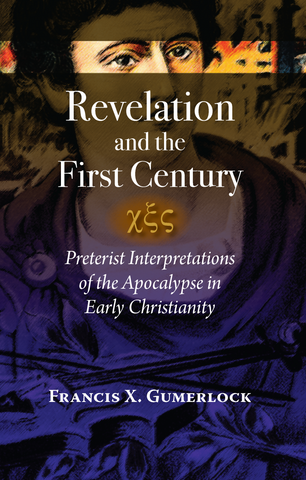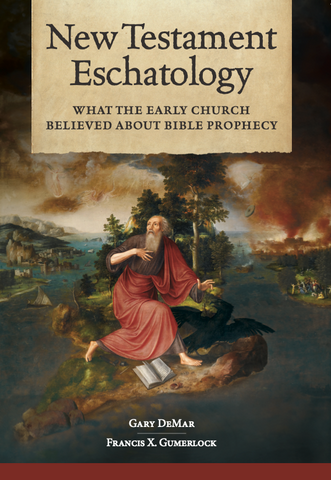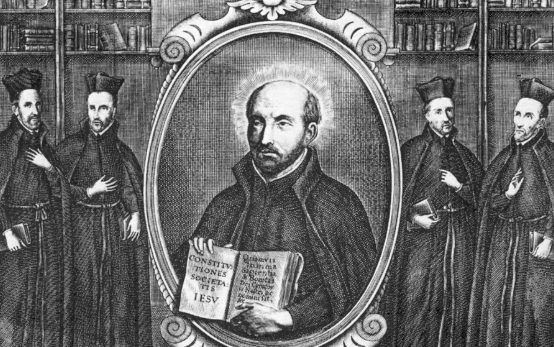One of the arguments used against a preterist interpretation of Revelation is that it was developed by Spanish Jesuit Luis De Alcazar (1554-1613) who wrote a commentary titled Vestigio Arcani Sensus in Apocaplysi or Investigation of the Hidden Sense of the Apocalypse and was published a year after his death. “In this work dedicated to the Catholic Church, he made a new attempt to interpret the Apocalypse by this Preterist scheme of exposition, that is, by the thesis that the prophecies were fulfilled in the past.” [1] Futurists use Alcasar (also spelled Alcazar) to poison the well. Since a Catholic proposed the view, so the argument goes, then it must be wrong because Roman Catholicism as a theological system is wrong.
Roman Catholics subscribe to the Apostles’ Creed and the Nicene-Constantinople Creed (325/381) as do Protestants. So how much of these Creeds are wrong given that Roman Catholics recite them (along with the Lord’s Prayer)? Poisoning the well is a poor way to argue. We might as well claim that the Volkswagen is an evil car because “Volkswagen was originally proposed in 1933 by Adolf Hitler, and superhighways should be torn up because of the German Autobahn.”
At the time Alcasar wrote, the Protestant Reformers considered the Papal system of the Roman Catholic Church to be the ongoing personification of antichrist. The Reformers were nearly unanimous in identifying the Papacy as the Great Harlot of Revelation 17. “For Martin Luther,” a representative of this view, “the Catholic Church was nothing more or less than Babylon—‘it would be no wonder,’ he wrote in 1520, ‘if God would rain fire and brimstone from heaven and sink Rome into the abyss, as He did Sodom and Gomorrah of old’—and the pope the Antichrist. ‘If he is not,’ Luther exclaimed, ‘then somebody tell me who is!’” [2] Hundreds of years of Protestant anti-Catholic rhetoric could fill a small library.
The papal system was identified as “both the ‘man of sin’ and the Babylonian whore of which Scripture speaks (2 Thess. 2; Rev. 17-18).[3] In the conviction of the sixteenth-century Protestants, Rome was the great anti-Christ, and so firmly did this belief become established that it was not until the nineteenth century that it was seriously questioned by evangelicals.” [4] For example, the Westminster Confession of Faith (1647) included the following in Chapter 25 section 6:
There is no other head of the church but the Lord Jesus Christ. Nor can the pope of Rome, in any sense, be head thereof: but is that Antichrist, that man of sin, and son of perdition, that exalteth himself, in the Church, against Christ and all that is called God.[5]
The antichrist designation was removed in 1789 in the American edition. The revised article reads, “There is no other head of the church but the Lord Jesus Christ. Nor can the pope of Rome, in any sense, be head thereof.”
There are groups today that still identify the papacy of the Roman Catholic Church as the antichrist (the historicist view of Revelation),[6] but most evangelicals no longer hold this position even though they (and I) disagree with many of the Roman Catholic Church’s doctrinal claims and practices.
Frank X. Gumerlock, writing in his book Revelation and the First Century, states that “Luis Alcasar’s commentary on Revelation, published in 1614, was not the first to take a preterist approach to the main body of the Apocalypse (Chs. 6–19). [John] Henten wrote his comments almost a century before the publication of Alcasar’s commentary.”[7]

Revelation and the First Century
The increase in understanding of biblical eschatology in recent decades has brought with it a return to biblical preterism—the view that much of biblical prophecy which we formerly considered to pertain to our future was actually fulfilled in the events surrounding the destruction of Jerusalem in A.D. 70. Critics of this viewpoint have often accused it of being “novel” in Christian history, and worse, some citing a Jesuit conspiracy in the 1600s for its origin! With Revelation and the First Century Francis Gumerlock has done an invaluable service to everyone interested in prophecy and church history. Dr. Gumerlock provides dozens of citations from early church history proving that many of them held a preterist view from the very first days of Christianity onward.
Buy NowIn 1545, Henten made these comments on the date of Revelation:
And first it seems to us that John, this apostle and evangelist who is called the Theologian, was exiled onto Patmos by Nero at the very same time in which he killed the blessed apostles of Christ Peter and Paul…. [and] that the Apocalypse was written on Patmos before the destruction of Jerusalem.[8]
According to Gumerlock, Henten (1499-1566), or Hentenius as he is also known, “held that Chapters 6-11 of Revelation referred to the abrogation of Judaism, and Chapters 12-19 referred to the destruction of Roman paganism.”[9] Non-preterists might argue that since Henten was a Roman Catholic, he could have had the same goal in mind that Alcasar had, even though they wrote independently of each other. There aren’t many commentaries on Revelation from the mid-16th century written by non-Catholics, so we don’t have a lot to go on. Neither Luther nor John Calvin wrote commentaries on Revelation.
But those who attack preterism because they claim a Roman Catholic originated it have a similar problem. Francisco Ribera (1537-1591) was a Jesuit Doctor of Theology in the Roman Catholic Church who began writing a lengthy (500 page) commentary in 1585 on the book of Revelation (Apocalypse) titled In Sacrum Beati Ioannis Apostoli, & Evangelistiae Apocalypsin Commentarij, and published it about the year 1590.
To remove the Catholic Church from consideration as the antichrist power, Ribera proposed that most of Revelation refers to the distant future before the second coming. “He taught that Antichrist would be a single individual, who would rebuild the temple in Jerusalem, abolish the Christian religion, deny Christ, be received by the Jews, pretend to be God, and conquer the world—and all in this brief space of three and one-half years.”[10]
Futurism is an interpretation of the book of Revelation developed by a Roman Catholic Jesuit Priest named Dr Francisco Ribera, (1537-1591). In Latin, Ribera wrote a five-hundred-page commentary on the book of Revelation entitled In Sacrum Beati Ioannis Apostoli, & Evangelistiae Apocalypsin Commentarij, meaning (In the Sacred Book of Blessed John the Apostle, and Commentary on the Gospel of the Apocalypse). Ribera desired to disprove the Protestant Reformers’ claim that the Pope was the Antichrist. In Ribera’s book he assigned the first three chapters of Revelation to the first Century and the remaining book of Revelation to a literal three and a half years appointed well into an unknowable future. He was the first to proclaim that a third Jewish temple would be built in Jerusalem. He also proclaimed that the futuristic Antichrist would abolish Christianity, deny Jesus, be received by the Jews, pretend to be God, kill the two witnesses and rule the world. The book was published and can be read online, 1591 edition, 1593 edition, and the 1603 edition.
*****
The first Protestant stooge to hoist the futurist banner was a Scottish Protestant clergyman named Edward Irving (1792–1834)…. Edward was captivated by the fantastical teachings of Jesuit futurism and the book penned by Juan Josafa Ben-Ezra. In 1827 Edward Irving translated and published Lacunza’s book “The Coming of Messiah in Glory and Majesty” into English, Volume 1, Volume 2. (Source)
Ribera’s view is like modern-day premillennialism. Let me poison the well a bit more. The Jehovah’s Witnesses follow an end-time scenario that is not much different from the one outlined in the Left Behind series. Appeals are made to 2 Timothy 3, parts of Daniel, and, of course, the Olivet Discourse in the three Gospels. Just like the dispensationalists, the JWs point to 2 Peter 3:3-4 to support their claim that those who do not believe we are living in the last days are “scoffers.” As evidence that we are living in the last days, like the dispensationalists, JWs point to “a tribulation that would be greater than any that had yet occurred.”[11]
Then there are the obligatory references to nation rising against nation, and kingdom against kingdom, earthquakes, pestilence, and what they believe is a yet future preaching of the gospel into all the world of our day.

New Testament Eschatology
Sometimes the historical record has been stretched and exaggerated to fit an already developed theory. But since the futurist perspective has been promoted as an early church reality by so many for so long, few question it. New Testament Eschatology challenges the prevailing futurist view with a careful study of the historical record. The evidence shows that many early church writers understood the destruction of Jerusalem in AD 70 to be the end of the Old Covenant world.
Buy NowYou will also find that JWs and dispensationalists share the belief that world wars, terrorism, tsunamis, an increase and the size and magnitude of earthquakes, diseases like malaria, influenza, and AIDs are empirical evidence that the end must be near. There is also the common belief that Armageddon is still in our future. Like the dispensationalists, JWs “are convinced of the reality of these prophecies.”[12]
If preterism should be discarded because of its supposed Jesuit beginnings, then futurism should similarly be discarded because of its Jesuit association. Preterism has a longer history going back beyond Ribera and Alcasar. F.W. Farrar puts the entire debate into perspective:
But to me it seems that the founder of the Preterist School is none other than St. John himself. For he records the Christ as saying to him when he was in the Spirit, ‘Write the things which thou sawest, and THE THINGS WHICH ARE, and the things which are about to happen (ha mellei ginesthai [ἃ μέλλειγενέσθαι]) after these things’ [Rev. 1:19]. No language surely could more clearly define the bearing of the Apocalypse. It is meant to describe the contemporary state of things in the Church and the world, and the events which were to follow in immediate sequence. If the Historical School can strain the latter words into an indication that we are (contrary to all analogy) to have a symbolic and unintelligible sketch of many centuries, the Preterist School may at any rate apply these words, ha eisen [ἃ εἰσὶν], ‘THE THINGS WHICH ARE,’ to vindicate the application of a large part of the Apocalypse to events nearly contemporary, while they also give the natural meaning to the subsequent clause by understanding it of events which were then on the horizon. The Seer emphatically says that the future events which he has to foreshadow will occur speedily (en taxei [“at hand”]) and the recurrent burden of his whole book is the nearness of the Advent (ho kairos engus [“the time is near”]). Language is simply meaningless if it is to be so manipulated by every successive commentator as to make the words “speedily” and “near” imply any number of centuries of delay.[13]
It is curious to see with what extraordinary ease commentators explain the perfectly simple and [un]ambiguous expression “speedily” (en taxei), to mean any length of time which they may choose to demand. The word “immediately,” in Matt. xxiv. 29, has been subject to similar handling, in which indeed all Scripture exegesis abounds. The failure to see that the Fall of Jerusalem and the end of the Mosaic Dispensation was a “Second Advent”—and the Second Advent contemplated in many of the New Testament prophecies — has led to a multitude of errors.”[14]
As Gumerlock and others have shown with the advent of translated works that have not been accessible in English, there is a long history of Christians long before either Ribera or Alcasar who interpreted parts of Revelation in a preteristic way. In the final analysis, Farrar is correct; it’s what the Bible says.
[1] Le Roy Froom, The Prophetic Faith of Our Fathers: The Historical Development of Prophetic Interpretation, 4 vols. (Washington D.C.: Review and Herald Publishing Association, 1948), 2:507.
[2] Arthur Herman, The Idea of Decline in Western History (New York: The Free Press, 1997), 19.
[3] Samuel J. Cassels, Christ and Antichrist or Jesus of Nazareth Proved to be the Messiah and the Papacy Proved to be the Antichrist(Philadelphia, PA: Presbyterian Board of Publication, 1846) .
[4] Iain Murray, The Puritan Hope: Revival and the Interpretation of Prophecy (London: Banner of Truth Trust, 1971), 41.
[6] See Dave Hunt, A Woman Rides the Beast: The Roman Catholic Church and the Last Days (Eugene, OR: Harvest House, 1994) and http://www.whitehorsemedia.com/articles/details.cfm?art=44
[7] Francis X. Gumerlock, Revelation and the First Century: Preterist Interpretations of the Apocalypse in Early Christianity (Powder Springs, GA: American Vision Press, 2012), 40.
[8] Johannes Henten, Enarrationes vetustissimorum theologorvm: in Actaqvidem Apostolorvm et in omnes D. Pavli ac Catholicas epistolas ab Oecumenio, in Apocalypsim verò, ab Aretha Caesareae Cappadociae episcopo manga cura collectae (Antwerp: Johannes Steelsius, 1545). Gumerlock’s translation of Primumque hoc nobis videtur, Johannem hunc Apostolum ac Evangelistam, qui et Theologus cognominatur, a Nerone in Patmos relegatum, eodem omnino tempore ille beatos Christi apostolos Petrum et Paulum interemit . . . quod scripta sit in Patmo Apocalypsis ante Ierosolymorum excidium.
[9] Gumerlock, Revelation and the First Century, 42.
[10] Froom, The Prophetic Faith of Our Fathers, 2:489-490. “Futurism arose first. Francisco Ribera, a Jesuit theologian, published a book on Revelation in 1590 called In Sacrum Beati Ioannis Apostoli, & Evangelistiae Apocalypsin Commentarij. By putting everything in the distant future, then obviously the Roman Catholic Church can’t be the bad guy. Robert Bellarmine, a Jesuit apologist, also took the futurist view in his work, Polemic Lectures Concerning the Disputed Points of the Christian Belief Against the Heretics of This Time. It was published somewhere between 1581 and 1593.”
[11] Awake! (April 2008), 4.
[12] Awake!, 7.
[13] Frederic W. Farrar, The Early Days of Christianity (New York: E. P. Dutton, 1882), 432-433.
[14] Farrar, The Early Days of Christianity, 432, note 2.

